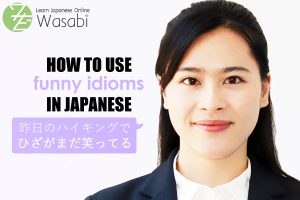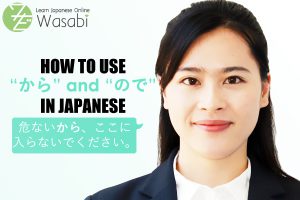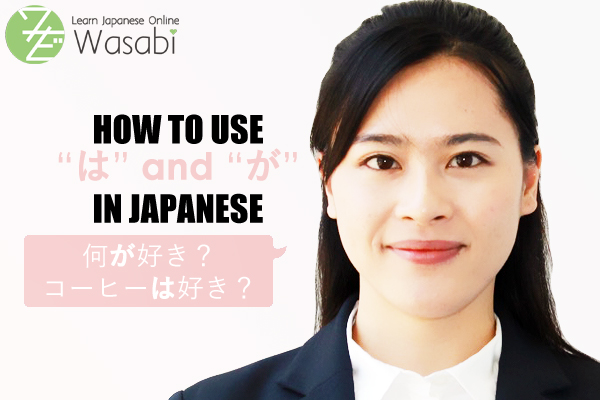The Difference Between “は” & “が” Explained
Welcome back to our “Video & Article” series with tutor Miki. In this article and video we will take a look at the particles “は” and “が”. While they can sometimes be used interchangeably, there are some major grammatical differences in their usage. Learn when to use which particle with this video and article!
| Table of Contents [Introduction] [Topic marker VS Subject marker] [When to use “が”] [When to use “は”] [Practice Examples] |
[Introduction]
In today’s lesson we will go over the two particles “は” and “が”. There is a lot of confusion around these two particles – sometimes they can be used interchangeably, and sometimes it is grammatically wrong or changes the meaning of the sentence when you use the wrong one. Let’s look at the basic functions of both particles and then dive deeper with some examples!
[adsense]
[Topic marker VS Subject marker]
First of all, it is important to note that “が” and “は” serve different grammatical functions. が is a subject marker while は is a topic marker.
が: Subject marker
は: Topic marker
Subject and topic are not the same thing. This is what many students get confused about, since there is no equivalent to a “topic marker” in English.
Now, a sentence usually consists of a subject and a verb: S+V. For example, “I eat”. “I” is the subject and “eat” is the verb. While the subject is easily identified as “I”, the topic refers to the entire context that is conveyed. So in this case, the whole sentence “I eat” is the topic of the sentence.
[When to use “が”]
Here is what traditional grammar books say about when to use “が”:
- が marks the subject (主語をあらわす)
E.g.: 桜が咲いた。
The cherry blossoms are blooming. - が emphasizes a subject by eliminating other options (主語を強調,排他)
あの子がこっそりチョコを食べた。
That boy secretly ate the chocolate (and nobody else but him). - が marks a subject to tell that the subject is making an action or is in a state of being (動作や状況などの対象を表す)
あの子がこっそりチョコを食べた。
The action of eating is marked. - が introduces a new topic (新しい事の導入)
むかしむかしあるところにおじいさんとおばあさんがいました。
Once upon a time, there were a grandma and a grandpa.
[When to use “は”]
Here is what traditional grammar books say about when to use “は”:
- は marks a topic
あの人は頭をかいています。
That person is scratching his head.
The topic here is the person. - は emphasizes the differences between two things
ほかの人は食べないけど私は食べます。
Other people might not eat it, but I will eat it.
The difference between people who would eat and not eat is established. - は tells the condition
ここにいてはいけない!
You cannot be here!
[Practice Examples]
“が” and “は” particles have pretty similar usages, but in a dialogue, the meaning tends to gravitate towards different directions. In other words, the meaning differs depending on the situation.
Tip: When you are having a conversation with someone, it is easier to start using particles correctly if you pay attention to what’s being asked or said right before you answer and adjust your own usage of particles. Let’s look at an example.
飲み物は何が好き?
What do you like to drink?
コーヒーが好き。
I like coffee.
じゃあ、カフェラテは好き?
Well, what about Cafe Latte? Do you like it?
んーあんまり。でもコーヒーは好き。
Hmm not so much, but I do like coffee.
You just need to match your particle to the question being asked right before.
Tip: When asking generic questions, it’s usually better to use “は”.
Do you know the popular movie “君の名は”, “What’s your name?”
Also often used:
トイレはどこですか?
Where is a restroom?
In conversation, if you’re confused, sometimes people eliminate wa and ga particles if a sentence is short.
トイレどこですか?
Tip: When asking questions with a question word, use “が”!
何が好き?誰が好き?
What do you like? Who do you like?
Another way to check whether you should use “は” or “が” is to see if you can refer to the subject/topic with “as for”, which is another way you can translate “は”. Look at this example emphasizing the difference between two things using “は”:
自然は好きだけど、虫は苦手。
As for nature, I like it, but as far as bugs are concerned, I don’t like them.
Lastly, what do you think these two sentences emphasize?
あーもうシャンプーはないのー。
“は” just generally emphasizing the topic – “There’s no shampoo!”
あーもうシャンプーがないのー。
“が” emphasizes the Shampoo, eliminating other options like conditioner or body soap that are still there. “We’re out of shampoo!”
It takes some time to understand which particle to use in every situation. But if you keep practicing and paying attention to where they are used, you will eventually get it! Thank you for reading today’s article, and please feel free to book a lesson with one of our tutors if you would like to study this topic further.
| こんがらがる | To get mixed up |
| 主語 | Subject |
| 強調 | Emphasis |
| 排他 | Exclusion |
| こっそり | Secretly, stealthily |
| 導入 | Introduction |

Eight funny & figurative idioms you need to know in Japanese

The Difference Between “から” & “ので” Explained



